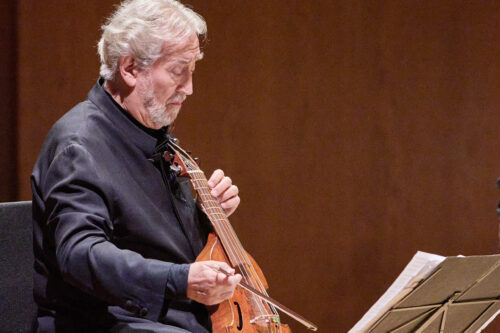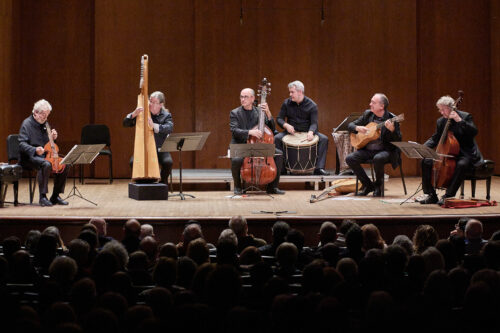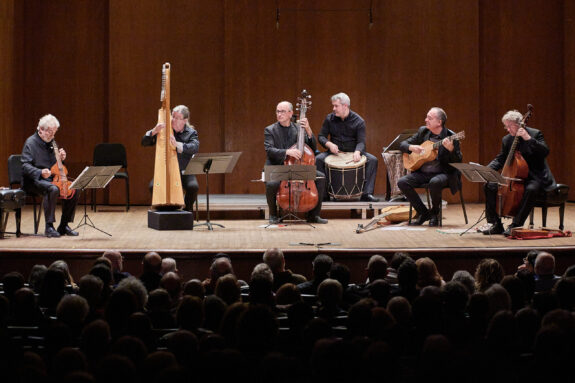 United States Various – ‘Music of Fire & Love’: Hespèrion XXI / Jordi Savall (director, treble viol). The 92nd Street Y, New York, 11.4.2025. (ES-S)
United States Various – ‘Music of Fire & Love’: Hespèrion XXI / Jordi Savall (director, treble viol). The 92nd Street Y, New York, 11.4.2025. (ES-S)

Few musicians have done as much as Jordi Savall to reclaim and breathe new life into the rich tapestry of musical traditions from the Renaissance and Baroque eras. For over five decades, Savall has tirelessly unearthed and illuminated forgotten works, creating vivid performances that seamlessly bridge scholarship with artistic brilliance. His ensemble, Hespèrion XXI, now celebrating its fiftieth anniversary, remains unmatched in its ability to transport audiences directly into the sonic worlds of past centuries. Their concert at The 92nd Street Y offered an expertly curated journey through European and Latin American music that ranged from spirited dances and poignant laments to virtuoso improvisations, embodying the very spirit of an epoch in which the distinctions between ‘popular’ and ‘serious’ or ‘low’ and ‘high’ were fluid and dynamic in the arts in general.
The program, bearing the suggestive title ‘Music of Fire & Love’ and the more elaborate subtitle ‘Folías, Battles & Lamenti – Glosados, Variations & Improvisations’, was one of the eclectic potpourris that Savall often assembles. Spanning nearly two centuries and crisscrossing the Iberian Peninsula, the British Isles, colonial Latin America and the Mediterranean, the evening presented less a linear narrative than a shifting mosaic of dances, laments and improvisations – some based on traditional grounds, others stitched together through sheer performative instinct. This was not a program in the conventional sense but a kind of historical meditation in motion: fluid, episodic and held together less by chronology than by sensibility.
As expected, Savall’s artistry stood at the heart of the entire evening. It unfolded not as a grand statement but through a series of precise, expressive interventions. In his ninth decade, still an active force on the international stage, he remains a musician whose authority is felt less in gesture than in gravity. In Couperin’s ‘Plainte pour les violes’, his treble viol line emerged with hushed clarity, each delicate dissonance shaped with care and released into silence. In Juan García de Zéspedes’s Guaracha, he brought a flash of rhythmic wit – entering just behind the beat, lending the music a buoyant, slightly off-kilter charm. Later, in Correa de Arauxo’s ‘Todo el mundo en general’, Savall’s viol line moved fluidly through the polyphonic texture, adding gentle ornamentation that enriched the solemn character of the hymn-based setting. A performer who listens as much as he leads, Savall conducted the ensemble with barely perceptible cues – a glance, a shift of breath – but the result was one of remarkable cohesion. The impression was not of direction imposed, but of shared understanding.

Named after the ancient Greek term ‘Hesperia’, referring to the western lands of Europe, Hespèrion XXI is comprised of exceptional musicians – each a specialist in historically informed performance on period instruments – who form an ensemble of remarkable cohesion.
On theorbo and guitar, Xavier Díaz-Latorre provided rhythmic clarity and harmonic depth, and he shone in Gaspar Sanz’s spirited Jácaras and Canarios. These pieces, with their expressive ornamentation and shifting metric patterns, demand agile phrasing and rhythmic flexibility; Díaz-Latorre met the challenges with flair, his rasgueado – a rapid strumming technique rooted in Iberian traditions – adding percussive brilliance that propelled the music’s dance rhythms.
Andrew Lawrence-King brought subtle luminosity to the ensemble’s sound on Baroque harp, his intricate figuration lending essential coloristic contrast. Whether weaving delicate textures into slower pieces or supplying rhythmic buoyancy in livelier dances, his playing maintained a sense of grace and fluid responsiveness that enriched multiple corners of the program.
The group’s foundation rested on the close rapport between Philippe Pierlot on treble and bass viols and Xavier Puertas on violone. Together, they shaped a grounded yet flexible bass layer, allowing harmonic nuance and structural clarity to emerge. Pierlot’s presence was especially felt in Couperin’s ‘Plainte pour les violes’, where his exchanges with Savall unfolded like a mournful dialogue – restrained, responsive and deeply attuned.
David Mayoral’s percussion work was indispensable – not merely rhythmic support but a source of playful spontaneity and expressive shading. Whether punctuating a lively dance or subtly animating a lament, his touch was always attuned to the character of the piece. Over the course of the evening, he drew from a veritable arsenal of instruments: frame drums, tambourines, shakers, hand cymbals and even ankle bells (cascabeles). His most applauded contribution came at the very end, in an encore performance of ‘Ballet à Cheval pour le Grand Carousel, fait à la Place Royale pour le Mariage de Louis XIII’, in which Mayoral mimicked the sound of horses’ hooves hitting the ground with uncanny precision.
Although the printed program outlined thematic groupings – from ‘Dances & Variations’ to ‘Catalan Laments’ to ‘Glosados and Improvisations’ – the concert flowed with an intuitive freedom that made such labels feel largely incidental. Pieces followed one another with little pause, connected more by resonance and contrast than by theme. Listeners drifted through a web of shifting textures and emotional registers – laments fading into dances, improvisations dissolving into set forms – until the structure itself seemed to vanish.
The folia – a wild and noisy Iberian carnival dance that evolved into one of the most enduring chord progressions in Western music – surfaced during the performance in one of its most striking transformations. The ‘Folías Criollas’ from the Codex Trujillo del Perú veered into exuberant, rhythmically dynamic territory, with the ensemble’s instrumentation adding vibrant textures that enlivened the phrasing. Here, the folía became not just a formal structure but a site of cultural cross-pollination – European forms meeting colonial imagination. A similar encounter occurred in the final piece on the program: ‘Gallarda Napolitana / Jarabe Loco’, where a stately European galliard, all ornamented poise and rhythmic balance, gave way to a deliberately unhinged reinterpretation – full of sudden syncopations, noisy asymmetries and rustic vigor.
The program’s many dance forms – jácaras, canarios, chaconas, paradetas – offered repeated glimpses of movement as musical principle. While their rhythms were grounded in tradition, the execution felt elastic and unpredictable, with shifts in articulation and pulse lending each piece a sense of spontaneity. Even in works built on regular ostinatos, there was little sense of stasis: the dances swelled, fragmented and reassembled with natural ease. Rather than reproducing historical stylizations, the ensemble conveyed the dances as living gestures – animated, social and playfully improvised.
The section titled ‘The King’s Men’ offered a glimpse into dance culture in the seventeenth-century British Isles – more measured and inward than the exuberant southern forms surrounding it. Works by William Brade and Robert Johnson combined courtly elegance with a gentle rhythmic lilt, their simplicity heightened by transparent textures and subtle inflections. Even in pieces like ‘The Satyrs’ Dance’, where energy briefly bubbled up, the music retained a certain reserve, favoring finesse over flair.
A later section, ‘The Island of the Chacona’ – where harpist Andrew Lawrence-King emerged as the primary voice – opened with another English work, Thomas Tomkins’s ‘A Sad Paven for These Distracted Tymes’, a somber lament on the execution of Charles I. The explanation for this sequencing might lie in the remarkable evolution of the chacona: a whirling dance that first appeared in South America at the end of the sixteenth century, it spread to Europe, became fashionable at the court of Versailles and eventually found expression as a vehicle for tragic soliloquy or lament, most famously in Bach’s Chaconne for Solo Violin. The printed program had originally placed the chaconas before the paven, following the logic of that transformation, but Lawrence-King proposed reversing the order – beginning with grief and allowing the music to move toward theatricality and release.
In this inverted trajectory, the section veered next into exuberance with the Chaconas & Paradetas from Luz y norte by Lucas Ruiz de Ribayaz and the Chacona by Santiago de Murcia. Along the way, Lawrence-King recited verses from ‘Island of Chacona’, a satirical seventeenth-century Spanish text describing a fantastical island in the New World where food and drink abound, and each man is assigned six serving girls – with new ones arriving weekly. Whether the imagined paradise inspired the carefree dance or vice versa is unclear; in either case, Lawrence-King’s intricate articulation brought color and vitality to the musical examples presented. Ornamentation was always in service of the underlying pulse and character, reminding listeners that the harp, in skilled hands, can sing, dance and meditate in equal measure.
What Savall brings to this kind of program is not just mastery or historical insight, but a gift for synthesis – for making the past feel cohesive, surprising and emotionally immediate. Through seemingly eclectic juxtapositions, he and his collaborators reveal deeper continuities: of rhythm, rhetoric and remembrance. In their hands, early music is not a museum of forms but a living theatre of sound.
Edward Sava-Segal
Pedro Guerrero – ‘La Moresca’
Anonymous – ‘Greensleeves to a Ground’ (romanesca)
Juan García de Zéspedes – Guaracha (improvisations)
Captain Hume – Almaine
Samuel Scheidt – ‘Galliard Battaglia’
Anonymous/ Jordi Savall – ‘Planctus – Mariagneta’ (arr. Jordi Savall)
Gaspar Sanz – Jácaras and Canarios from Instrucción de música sobre la guitarra española
Baltasar Jaime Martínez Compañon – ‘Tonada de El Chimo’ and ‘Cachua serranita’ from Codex Trujillo del Perú
Robert Johnson – ‘The Noblemen’
William Brade – ‘Scottish Dance’
Johnson/ Brade – ‘The Satyrs’ Dance’
François Couperin – ‘Prélude’, ‘Plainte pour les violes’, ‘Muzette’
Thomas Tomkins – ‘A Sad Paven for These Distracted Tymes’
Santiago de Murcia – ‘Cumbees’ from Codex Saldivar, Chacona
Lucas Ruiz de Ribayaz – Chaconas and Paradetas (improvisations) from Luz y norte
Francisco Correa de Arauxo – ‘Todo el mundo en general’
Anonymous – Canarios (improvisations)
Antonio Valente / Anonymous Jarocho – ‘Gallarda napolitana / Jarabe loco’
